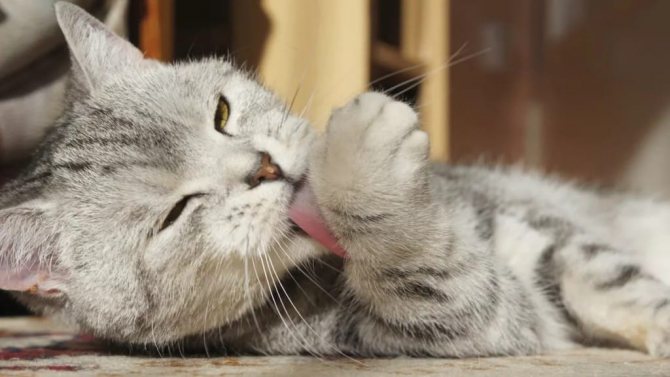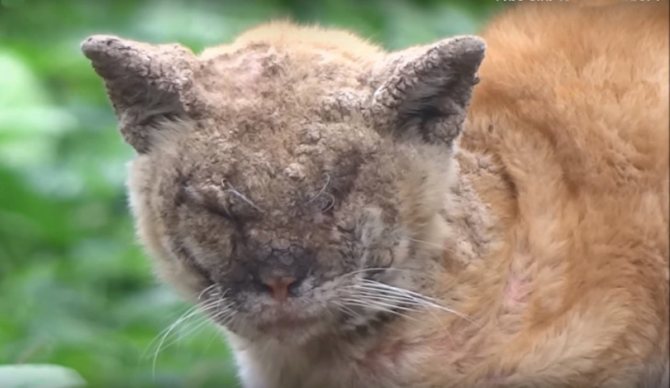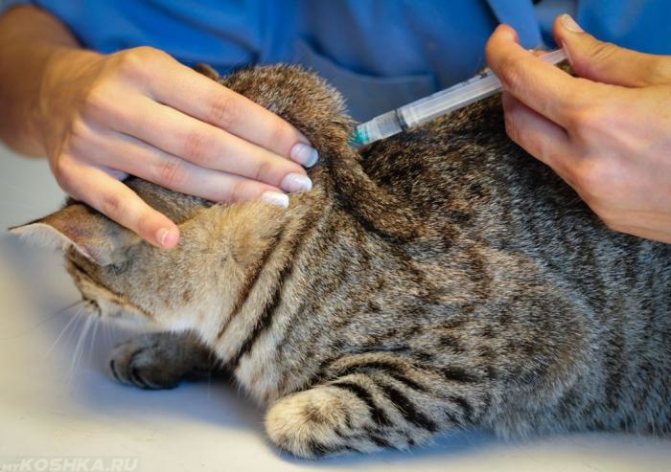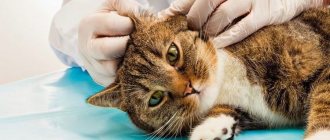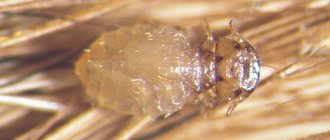Types of mite scabies
The disease provokes several types of parasites. Symptoms are similar, the location of the tick differs.
- Sarcoptic mange. The causative agent is Sarcoptes scabiei or itch itching. It parasitizes in most cases on humans, dogs, and rarely affects cats. The main symptoms are hair loss on the abdomen, muzzle, behind the ears, on the elbows.
- Scabies. The disease is provoked by the Notoedres cati tick. The microscopic parasite initially settles on the face and ears. Severe, persistent itching causes the cat to scratch constantly, which aggravates the course of the disease. Infection penetrates the bloody wounds, and even more scabies mites settle.
- Demodectic mange. A form of scabies not common to cats. Dogs with weak immunity are ill. The causative agents of infection - Demodex folliculorum, Demodex brevis are constantly present on the body of cats, but do not cause harm.
- Otodectosis. Ear scabies are caused by the mites Otodectes cynotis. The parasite settles in the ear canals, feeds on secretions, makes numerous moves. With prolonged infection, the ear canal is completely closed, the cat loses its hearing.
All types of mite scabies are highly curable. For therapy, special drugs, folk remedies are used. A photo of a scabies mite in cats is presented below.
Disease symptoms, diagnosis
It is impossible to see the parasite with the naked eye. To confirm the diagnosis, you need to make a scraping from the affected areas of the skin. You can predict the presence of an itch mite by the following symptoms:
- anxiety;
- irritability;
- drowsiness or insomnia;
- loss of appetite;
- weight loss;
- scratching the skin;
- baldness of individual areas, hair loss;
- the presence of abscesses, ulcers, inflamed spots;
- the presence of pus, discharge in the auricle.

Scabies mite in cats
The diagnosis begins with an examination of the animal. If the cat has signs of damage to the skin, ears, you need to consult a veterinarian.
The scabies mite in a cat is a frequent phenomenon, but the parasite mainly affects sick, weakened animals with low immunity. Kittens of different ages are often affected.
Treating scabies mites in cats
Therapeutic measures are aimed at eliminating symptoms, destroying the parasite, and strengthening immunity. Professional preparations for scabies mite are produced in the form of drops, tablets, ointments, cream, lotion, spray. Means for enhancing the protective functions of the body - Gamavit, Tetravit. The dosage is selected individually. The choice of specific antiparasitic agents depends on the type of scabies mite.
- Lime sulfur (LymDip). The solution is applied once a week. The course consists of 6 procedures. To increase the effectiveness of the drug, wool is cut off in places of greatest infection. Before treating the cat with sulfur, it is recommended to wash it with a keratolytic shampoo. Sulfur cost from 10 rubles.
- Ivermectin (Ivomec). The drug is used daily for 5 days. The cat recovers completely after a month. Price from 400 rubles.
- Amitraz (Mitaban). The treatment lasts 2 weeks, the remedy is applied during all this time 8 times. Causes a number of side effects, so it should not be used in sick, weakened animals, kittens. The cost is within 40 rubles.
- Selamectin (REVOLUTION). Avermectin-based product that is completely safe for cats. Absorbs quickly, relieves symptoms almost instantly. To get rid of scabies, to destroy the scabies mite, 1 treatment is enough. The price is about 300 rubles.
- Benzyl benzoate emulsion. Rub into the affected areas of the skin every 3 days for 2 weeks. Elimination of unpleasant symptoms occurs after the first procedure. On average, 100 rubles.


Treating scabies mites in cats
As an additional therapy, Stop Itching is prescribed. It is produced in the form of a suspension. Normalizes sebum production. Injected with a syringe without a needle into the cat's mouth. With ear scabies, drops for cats Ivermectin, Acaromectin are dripped into both ears, smeared with Otoferolone, Stronghold.
Preventive measures
In order to prevent your pet from becoming infected with itch mites, it is worth limiting its contact with street animals.


At least once every six months, it is recommended to carry out preventive treatment of wool from ectoparasites using antiparasitic drops, solutions, sprays based on selamectin.
For preventive purposes, during the bathing process, special shampoos for animals and insecticidal agents are used, which can be purchased at a veterinary pharmacy, a veterinary clinic or a pet store. For the same purpose, you can purchase a special collar for a cat.
Inspect the fur of the animal after each walk. Do not forget about hygiene procedures and support the pet's body with products aimed at strengthening the immune system. To do this, introduce mineral and vitamin complexes into the cat's diet.
Ticks do not survive if the house is regularly cleaned, tidied up and washed. Preventive measures can help minimize the risk of your pet getting scabies. Take care of your kitty one hundred percent, and then the tick is unlikely to be able to settle for a long time in her fur and in your house.
Home treatment with folk remedies
There are several proven recipes that can help treat scabies:
- In a 1: 3 ratio, dilute black powder or sulfur powder in kefir. Stir thoroughly, leave in a dark place for 3 hours. The affected areas of the skin are treated once a day. The residues are washed off with water, wiped off with napkins, since the product dries the skin very much.
- Rub the skin of a sick cat with sulfuric ointment, ash. Wrap up with foil for 15 minutes. The procedure is repeated 3 times a day. After 5 days, treatment is continued with the existing signs of scabies.
- Lard, laundry soap, birch tar are mixed in equal proportions. Add a double portion of the sulfur. Apply the mass to the body of the cat, after half an hour wipe it off with napkins. The course of therapy is about a week.
Treatment reviews
How long to treat the disease, by what means, depends on the type of scabies mite, the age of the cat, and individual characteristics. Sometimes doctors prescribe complex therapy.


Scabies mite in cats
The kitten was prescribed a whole bunch of drugs for the treatment of scabies: Lamisil in tablets, Vakderm, Gamavit, Clotrimazole ointment. Then they added an antibiotic, hemobalance, Lamisil shampoo. She began to stuff the animal with all this. Within 5 days it only got worse. The suspicion that this is from the side effects of all these medications. Then he began to doubt the correctness of the treatment - parasitic scabies, antifungal drugs were prescribed.
We have a homeless cat in our yard. Several times people tried to take him to them, but again he runs into the street. Last year I caught scabies and felt sorry for the poor fellow. Cured with Otodectin injections. They didn't give him anything else.
For the treatment of the cat I bought the drug Ivermek. I pricked injections. Cured in a week. I also bathed Nizoral. The veterinarian advised Stronghold drops. I didn’t find it in pharmacies in our city, I didn’t want to order via the Internet - it’s a long time to wait. Ivermek helped.
After successful therapy, it is important to observe preventive measures, immunity to scabies mites is not developed.
Each owner sooner or later encounters itching in his pet. The main cause of itching is parasites - fleas. But this is not the only reason why a cat may actively itch. Scabies in cats is caused by a mite that lives in the epidermis. In addition to cats, the mite infects the skin of dogs and rats.
Itching is caused by the activity of mites in your pet's skin. The parasite gnaws through the cat's epidermis, forms a network of micro-passages, in which it then multiplies. Therefore, scabies in cats is a parasitic disease! There are several types of parasites that cause itching in an animal, the course of the disease, localization and treatment will depend on its type. There are such types:
- Scabies, and the disease is sarcoptic mange (ear scabies). It is localized on the ears, abdomen and joints of the animal. The most important symptom by which one can judge that the pet has sarcoptic mange is itching in the ears. The first test will be a microscopy test.
- Notoedres, disease - notoedrosis. The most contagious form of scabies, it is easily transmitted to other animals and humans. The disease begins on the face and quickly spreads throughout the body.
- Cheyletiella, cheyletiellosis is the most noticeable disease for the owner. In addition to severe itching, the animal has dandruff and red spots on the body.


How to find out the cause of itchy skin and help your pet?
Unfortunately, even for a veterinarian, it is not always easy to determine the cause of itching. Sometimes an extensive examination is needed to draw a definite conclusion and make a diagnosis. As the pet owner, you can make it easier for your veterinarian to provide detailed information about your cat's circumstances and medical history. For example, if itching occurs seasonally only at certain times of the year, it is likely that the cat has an allergic reaction to tree or grass pollen. In this case, atopic dermatitis can be suspected. Or maybe the cat itches especially badly if it has eaten certain foods? Or does she have fleas? In fact, there are many possible reasons, every detail matters!
In addition, the itching itself can cause a separate disease if the cat has damaged the skin with constant scratching. The damaged skin does not protect the animal from pathogenic microorganisms, therefore, a secondary infection joins: the skin turns red and inflamed, foci of baldness, papules, etc. appear.
Don't risk the health of your four-legged friend! Self-medication attempts can have undesirable and unpredictable results! See your dermatologist veterinarian for help.
Symptoms
Scabies in a pet is very hard not to notice! First of all, the tick makes the cat want to scratch. Also, the disease is accompanied by a complex of other symptoms that should attract the attention of the owner.:
- hair loss in large areas starting from the head and ears
- scratches and wounds on the skin
- the cat itches all the time
- dark crusts at the site of scratching
- skin tightening
- the head, ears, muzzle are affected first, then the abdomen and the rest of the body
- loss of appetite, refusal of favorite treats
- tiredness, weakness
- decreased activity
In severe, neglected cases, this symptomatology is visible with the naked eye, at the initial stage, the owner should be attracted by the itching and anxiety of the cat.
For an accurate diagnosis of the disease and the appointment of treatment, you must definitely visit a veterinarian! An important part of the diagnosis is scraping the cat's skin. In no case should the disease be ignored, since a person can contract scabies from a cat! If the disease is started, it will lead to exhaustion of the cat, blood damage, and death of the pet.Sometimes other diseases have similar symptoms to scabies: food allergies, vitamin deficiencies of various nature.
Scabies treatment
Treating scabies in cats is almost always possible at home. Only in the most difficult stages does the doctor recommend a hospital. For treatment, both injections and ointments, various drops are used. Only a qualified physician should prescribe medications. injections and ointments are extremely toxic not only for parasites, but also for the animal itself.


An affordable and easy-to-use method of treating a pet for scabies. For this, preparations based on sulfur or aversectin ointment are used.
How to choose an effective itch medication for your cat?
The choice of an effective drug for itching in a cat is considered a responsible event, since it depends on whether the animal will suffer or not. This is especially true for situations associated with diseases of fungal and bacterial origin, in which pets itch to sores and blood. The situation is even more complicated with allergic itching, which can be caused not only by direct contact with a potential allergen, but also by improperly selected food.
| A drug | Release form | Manufacturer | Active substance | Price |
| Stop-Itching Suspension | Suspension | Russia | glucocorticoid-based | from 250 rub. |
| Stop-Itching Spray | Spray | Russia | glucocorticoid-based | from 300 p. |
| Cytoderm | Shampoo | Russia | Diethylene glycol monoethyl ether | from 250 p. |
| Beefar | Shampoo | Netherlands | Propanediol | from 600 rub. |
Treatment with folk methods
Alternative methods can also be used to treat mild stages. However, a guaranteed cure is provided only by official methods of treatment.


Kefir with gunpowder.
This mixture is prepared in a 1: 3 ratio, stir thoroughly and let it brew warm. Use on bald patches once a day. After waiting for drying, rinse thoroughly.
Grandma's remedy.
A mixture of sulfur, birch tar, lard and crushed laundry soap in a ratio of 2: 1: 1: 1 is applied to the affected areas once a day for 15-20 minutes, then completely remove with a napkin and rinse the application site. It is not recommended to use for more than seven days.
- A mixture of laurel and olive oil.
- Crushed bay leaves are mixed with olive oil to form a thick gruel. The ready-made mixture is applied to the skin 3 times a day until complete recovery. Keep refrigerated.
Prevention of scabies in pets
Scabies is a contact disease and is easily transmitted by contact of a sick animal with healthy pets or humans. To exclude infection, a number of simple rules should be followed.:
- If animals with scabies symptoms appear in your pet's environment, all contact should be stopped immediately. When scratching, a sick animal can brush ticks to the ground or immediately onto your pet.
- The use of drops and collars from parasites, if pets walk on the street and come into contact with other people's animals. The collar should be changed in accordance with the instructions (most often every 90 days), and the drops should be instilled every 2-3 weeks.
- Treatment of the habitat of the infected animal and all objects used by the cat. This includes bowls, toys, and bedding that should be given special attention. They must be treated with disinfectants and exposed to high temperatures to kill parasites and prevent re-infection.
- Balanced diet. Parasites feed on the blood of the animal, so there is a high risk of general depletion of the body. A balanced diet is necessary, it is possible to use vitamin and mineral complexes to support the body.
How to properly treat demodicosis in animals
As for the foci of demodicosis, they are mostly eliminated with the help of therapy, which is performed in a complex:
- Initially, effective elimination of ticks is performed by sanitizing the surface of the cat's skin.
- For topical application, in most cases, solutions recommended by a veterinarian are used.
- In order for the cat's body to independently resist the scabies mite, it is considered appropriate to use a variety of immunostimulants. Thus, if the pet's immune system is strong enough, then the treatment will be more effective, and the effect from it will be much more stable.
- If a very strong inflammation is observed on the cat's skin, then in this case, special ointments are used to completely eliminate it, they should be prescribed exclusively by a veterinarian.
"As for the main action of these drugs, in most cases they eliminate not only the focus of the disease, but also effectively relieve the inflammatory process on the surface of the epidermal layer of the cat's skin."
The question of whether scabies is transmitted from a cat to a person remains open, since at first glance it is completely impossible to determine which type of scabies mite is observed in your pet. Therefore, as soon as the cat begins to scratch its skin, you should immediately seek the advice of a highly qualified veterinarian, which will also positively affect both the course of the disease and the speed of its complete elimination.
Symptoms
Most often, ticks first appear on the ears and head of the animal, and then spread throughout the body of the cat. The main clinical signs of scabies are:
1. Skin itching. It is caused by the vital activity of ticks that bite the animal, drink its blood and move along the itch passages. All this leads to the fact that the cat constantly itches and licks the affected skin.


2. Hair loss. First, the ears of the animal go bald, then the hair begins to fall out on the head and neck. Gradually, the process moves to other parts of the body and the areas of baldness increase.


3. Reddening of the skin in places where parasites are introduced, the appearance of crusts and scales on its surface.
4. The appearance of scratches, abscesses and small rashes, which, if untreated, begin to fester. After opening the abscesses, dark crusts remain on the skin.
5. When the tick is close to the lymph nodes, their enlargement is observed.
If scabies is not treated, then various complications may occur, for example, the addition of a secondary infection, which worsens the prognosis of the disease.
The cat is combing itself until it bleeds and has severe itching.
There are a number of diseases in which a cat scratches itself up to the appearance of multiple blood crusts and wounds. Both external and internal factors can cause the appearance of a symptom.


External include various dermatological and infectious diseases, as well as infection with parasites. Internal factors include pathologies of the kidneys, cardiovascular system, and organs of the gastrointestinal tract.
Worms (helminths)
Helminthiases are an extensive group of diseases caused by the invasion of parasitic worms. There are many pathogens that affect the internal organs of cats. Infection, as a rule, occurs through the fecal-oral route, that is, when eating food that has come into contact with contaminated feces, as well as through contaminated soil and plants.
The parasite that has entered the body of a cat, depending on the species, affects organs, most often the gastrointestinal tract. The clinical picture is represented by the appearance of itching in the anal sphincter, increased or decreased appetite, general signs of intoxication syndrome - the animal becomes restless, sleep is disturbed, lethargy and decreased mobility appear. With the progression of the disease, a change in stool is noted - frequent diarrhea appears, in some cases, you can notice the presence of a parasite in the feces with the naked eye.
Another sign of the presence of a parasite in the cat's body is the deterioration of the quality of the coat - the hairline loses its shine, possibly increased hair loss.
Inflammation due to bacteria
Severe scratching on the body of a cat can appear against the background of infection with pathogenic bacteria. Pathology develops when existing wounds and abrasions are infected. In the affected area, a site of local inflammation is formed, with the development of edema, redness of the dermis, as well as the appearance of abscesses.
With a decrease in the immune response, an abscess may occur.
The clinical picture of the pathology is represented by itchy skin, increased body temperature, decreased activity of the pet. In the absence of effective therapy, the pathological process can lead to the spread of infection.
Pyoderma
Pyoderma is a disease caused by infection of the skin with pathogenic bacteria. The disease can be both independent and secondary.
The main clinical manifestation of the disease is the formation of lesions with purulent contents on the skin. In this case, the cat experiences intense itching, as a result of which it scratches the abscesses up to the formation of blood crusts.
Most often, the infectious process is localized in the chin, on the surface of the extremities, back.
The pathological process can be:
- superficial - the infection affects the upper layers of the skin;
- deep - the deep layers of the dermis are affected, while the disease proceeds in a more severe form.
Superficial pyoderma may be due to the development of:
- impetigo - pathogenic bacteria infect the stratum corneum of the skin with the formation of small abscesses;
- folliculitis - the infection is localized in the cavity of the hair follicles. Most often, this form is observed in kittens.
The clinical picture is presented by an external manifestation in the form of pustules on the skin, an unpleasant odor may appear. In the affected area, an inflammatory process forms, with reddening of the skin, a local increase in temperature, the outflow of exudate, as a result of which the animal's hair acquires an untidy appearance, mats are formed.
Otitis media (ear inflammation)
Otitis media is a disease characterized by the development of inflammation localized in the outer, middle or inner ear. The etiological factor in the development of the disease is:
- bacterial infection;
- fungal infection;
- allergic reaction;
- infestation with parasites.
The clinical picture depends on the cause of the inflammatory process of the ear. When infected with a tick, as a rule, the outer ear is affected, and numerous brown crusts, scratches and abrasions appear on its surface.
An allergic reaction manifests itself against the background of contact with an allergen. In addition to itching in the ears and the development of inflammation, general malaise, drowsiness, apathy of the animal, as well as damage to the skin in other parts of the body, are possible.
Otitis media of bacterial nature can develop as an independent disease due to a decrease in the immune status. A secondary infection is added if there is damage to the ear.
Leeshai (scratching until bloody)
Lichen is a group of diseases of various etiology, which manifest themselves in the form of small itchy nodules on the affected area of the skin.
- Ringworm is a disease caused by a fungal pathogen of the genus Microsporum. The clinical picture is characterized by the appearance of one or more areas of bald patches on the animal's coat. The affected dermis is characterized by dryness and scaling, the presence of small nodules without exudate. Characterized by severe itching, redness at the site of localization of the pathogen. The size of the bald patches varies from small islets to extensive areas of fungal infection. The infection is dangerous for humans - with close contact with an animal, the risk of morbidity reaches almost 90%.
- Pink lichen is a disease, the etiological factor of which is infection with a virus and the development of allergies. The nature of the disease is not completely clear. Most often, cats with a pronounced decrease in immune status are exposed to the disease. The risk factor is old age and the period up to a year, as well as the presence of chronic diseases. The clinical picture is characterized by the formation of flaky pink formations on the skin of a pet with a rounded shape.
- Pityriasis versicolor is characterized by a fungal infection of the stratum corneum of the skin. The causative agent is a fungus of the genus Pityrosporum. Clinical manifestations are represented by the formation of small colored spots on the surface of the cat's body, the occurrence of itching. Elements of the rash can disappear when the ambient temperature drops. The disease is transmitted to humans, therefore, if a pet is infected with this disease, safety measures should be taken.
- Lice, mites and skin parasites
Pediculosis in cats is most often caused by an infestation of Felicola subrostratus lice. Parasites have a piercing-sucking apparatus, with the help of which the skin is pierced and the pathogen is fed with blood. During damage to the dermis, the louse injects an anticoagulant compound, resulting in the formation of a local inflammatory process, irritation and itching.
Tick-borne lesions are characterized by a wide variety:
- the ear mite is localized in the outer ear, but can move to the inner and even to the meninges, causing encephalitis;
- hair mite causes demodicosis. Pathogens are microscopic parasites, which have recently been classified as opportunistic microorganisms. The disease is characterized by the appearance of areas of baldness on the cat's body, while the skin becomes pale and dry. Mild forms of the disease can go away on their own, they respond well to treatment. In the case of a generalized infection or with a juvenile form, damage to internal organs may occur;
- subcutaneous mites cause notoedrosis, cheiletiellosis and other ailments;
- the scabies mite Sarcoptes scabiei is the causative agent of scabies. The pathogen lives under the skin, lays passages in it, as a result of which severe itching develops.
Other skin parasites are fleas. Settling on the skin of a cat, pathogens cause inflammation due to bites, saliva getting into wounds, and decomposition of dead individuals. These parasites can cause an allergic reaction, as well as infect a pet with dangerous diseases. Fleas carry tularemia, hemobartonellosis and other infectious diseases.
It is important to read about why fleas can appear even in a domestic cat or cat.
Allergies
Allergic reactions are an inadequate response of the immune system to the ingestion of an allergen. Pathology is most often recorded for food, dust, household chemicals. The clinical picture is presented by various skin lesions in the form of urticaria or dermatitis. In this case, the cat experiences severe itching, so scratching and sores may appear. In severe cases, anaphylactic shock, bronchospasm and other life-threatening symptoms may develop.
Hormonal disruptions
- Cushing's syndrome is a pathology caused by an increase in the production of steroid hormones by the adrenal glands, or by the direct systematic administration of glucocorticosteroids in the treatment of various diseases. Adrenal hormones play an important role in many processes in the body. With an increase in their concentration in the blood, a failure occurs in all types of metabolism. The clinical picture is characterized by the development of obesity, there is a pronounced thirst as a result of a violation of the water-salt balance, urine output increases. There is the development of atrophic changes in the muscles, dullness and loss of hair, dandruff, and itchy skin.
- Hypothyroidism is a pathology of the thyroid gland or pituitary gland, in which there is an insufficient production of thyroid hormones, which are responsible for metabolic activity. The disease is accompanied by a decrease in the activity of the cat, peeling of the skin, itching, and an increase in body weight. The disease is rare in cats and is most often caused by removal of the thyroid gland or prior radiotherapy for hyperthyroidism.
- Diabetes mellitus is a disease characterized by an increase in the concentration of glucose in the blood as a result of damage to the pancreas or glucose tolerance. The disease has a systemic effect on the entire body of the pet, including the skin.
Scabies treatment
First of all, they get rid of the scabies mite, after which they begin symptomatic treatment of the disease. The most effective medicines for treating scabies in cats are:
They all come in the form of a liquid for injection. In addition to injections, the complex therapy of the disease includes external agents - sprays and ointments.
To increase the immune defense of the animal body, the use of the drug Immunoparasitan is shown. It protects the cat from re-infection with scabies.
To relieve inflammation, agents containing tar, sea buckthorn oil, sulfur, and so on are used.
To restore the vitality and health of the animal, multivitamin and mineral complexes are prescribed.
It is important to follow the rules of hygiene. All items used by the cat must be disinfected. The same must be done with all the places where the animal plays, rests or sleeps.
Disinfection needs to be done several times until the symptoms of scabies completely disappear.
While the animal is sick, it is better to temporarily limit contact with it, because scabies can be transmitted from animal to person.
You do not need to lean the cat against your clothes and touch it with your bare hands. If there are children in the family, it is necessary to completely exclude the possibility of their contact with a sick animal. For the period of treatment, the cat needs to be allocated a separate place so that the disease does not spread throughout the house.
Itching prevention
In order to avoid the development of diseases accompanied by itching, the following rules should be adhered to:
- Regularly give your pet remedies for worms, do not feed raw meat and fish.
- After returning the animal to the house from the street, inspect for wounds and cuts, if found, treat them with an antiseptic.
- Protect from contact with infected animals.
- Periodically disinfect the pet's tray.
- Transfer the cat to a new diet gradually.
- Protect your pet from stress.
If you have an itchy cat, you need to see a doctor. You cannot try to identify and eliminate the disease yourself.
Recommended entries
Description and content of the hunting border terrier
Standard for the height and weight of the Cane Corso breed by month
Description and care of the highly intelligent Border Collie breed
History of origin and characteristics of the British cat
Husky weight standard and sizes by month
Why does a cat eat its kittens after giving birth?
What can you do at home?
In most cases, the main stages of treating cats with scabies are carried out at home. Naturally, before starting therapy, the animal must be shown to the veterinarian, who will make an accurate diagnosis and prescribe treatment.
Antiparasitic baths are often prescribed to treat scabies. It should be remembered that they do not threaten the cat's health, but they can damage some interior items (for example, porcelain or acrylic bathtubs). In addition, sulfur-based preparations widely used in the treatment of scabies have an extremely unpleasant smell of rotten eggs.
When carrying out medical manipulations, it is imperative to use gloves.Ideally, it is better to bathe the cat in the open air and run it into the house only after the coat is completely dry.
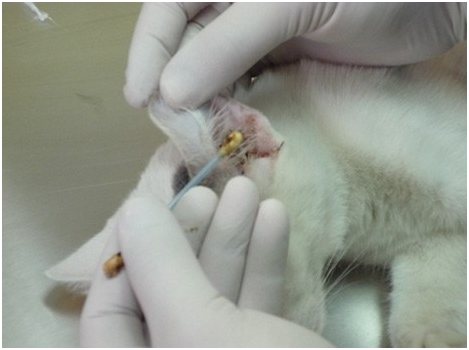

This will help prevent damage to carpets and furniture, which can turn yellow. Ticks do not live long outside the host's body. To prevent re-infection, it is usually sufficient to regularly clean the floors in the house, vacuum the carpets, and wash clothes.
It must be remembered that the feline scabies mite can be transmitted to humans, therefore, safety measures must be taken when handling an infected animal.


